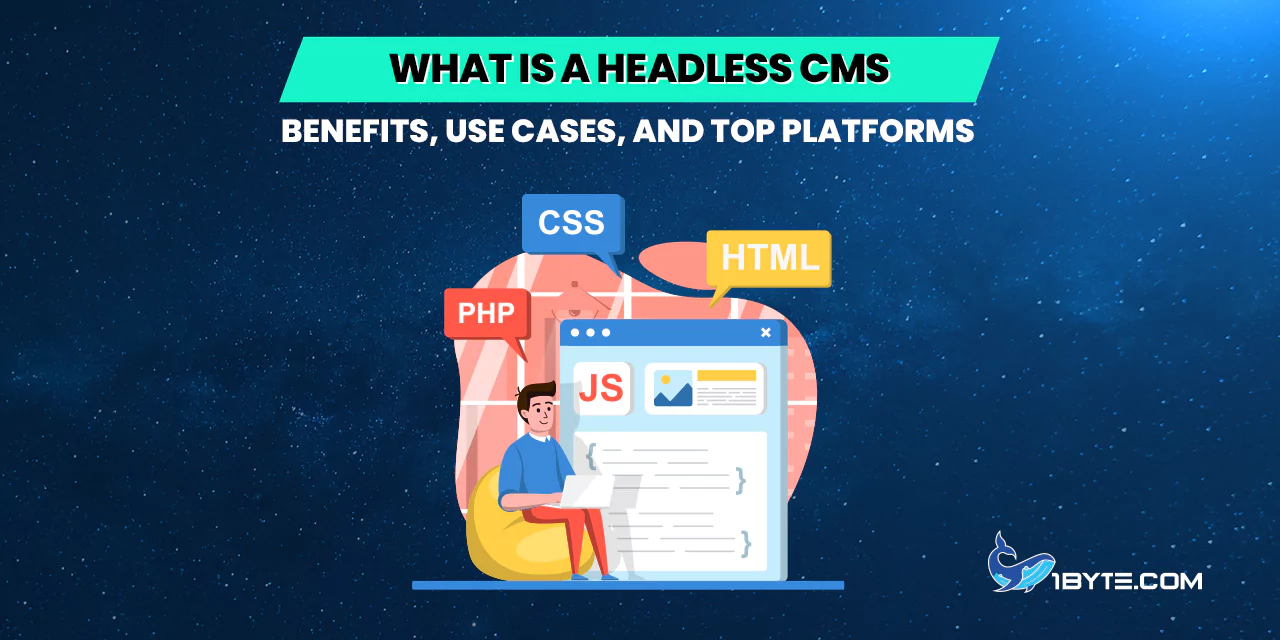Modern digital platforms demand flexible content solutions. Traditional content management systems (CMS) often struggle to deliver content across the growing number of channels and devices. Many organizations are now asking what is a headless CMS and how it can meet these needs. The term headless CMS refers to a content management system that decouples the content backend from the presentation frontend. This approach is transforming how businesses manage and deliver content, with adoption surging worldwide. In fact, nearly 73% of businesses were using headless architecture by 2024, a jump of almost 40% since 2019. This article from 1Byte provides a clear explanation of what a headless CMS is, outlines its key benefits and use cases, and highlights top headless CMS platforms in the market.
What is a Headless CMS?
A content management system (CMS is an acronym of Content Management System) is a headless content management system that separates the frontend and backend of a content management system. In the traditional CMS, the content and its presentation are closely coupled in the same system. In comparison, a headless CMS does not have a fixed frontend or head. Instead, it stores and manages content centrally and provides it via APIs to any frontend or device. It implies that once created in the backend, content can be published everywhere on websites, mobile apps, smart devices, or any other digital channel.

A headless CMS, in practice, is a content hub. Content editors insert and manage text, images and other assets in the backend interface. The developers construct the websites or applications, the so-called heads, independently, accessing the content in the CMS via API calls. This decoupled design allows the developers to be free to work on any front end programming language or framework. It also gives the content creators the ability to reuse and repurpose content across platforms without duplication. One of the most popular platforms, Contentful, describes this decoupling as unlocking your content, so that marketers can manage their content without developers and developers can build faster and at scale. In a traditional system, the content is often mixed with code, but in a headless CMS, it is kept structured and portable, which is fundamental to the modern omnichannel experience.
Why “headless”? The name is based on the notion that the head is cut off (the frontend presentation) and only the body is left (the content repository). The CMS is not dependent on any specific output by eliminating the predetermined head. This has been a remedy to the necessity of multichannel content delivery. When companies started to distribute the content not only to web pages, but also to mobile applications, smart watches, voice assistants, and so on, they required a more adaptable CMS. A headless CMS is used to meet this need as it is frontend-agnostic and content and data can be delivered to any device or platform via APIs. This versatility has made the adoption of headless CMS to have gained a lot of momentum over the past few years.
It’s important to note that headless CMS is sometimes called a decoupled CMS, though there are slight distinctions. A decoupled CMS still provides a default front-end that you can use or ignore, whereas a pure headless CMS provides no built-in front-end at all. In both cases, the philosophy is the same – the content management backend is separate from the presentation, enabling a “create once, publish anywhere” model. Nearly half of organizations (44%) already had a headless CMS in place by 2023, and this number has continued to grow as businesses recognize the need for agility in content delivery.
Benefits of Headless CMS
The use of a headless CMS has the potential to bring many advantages to organizations that want to modernize their online presence. Some of the most important advantages of a headless CMS are supported by recent statistics and examples as follows:
Omnichannel Content Delivery
The ability to publish content across various channels through a single source is also possible with a headless CMS. The content is served through APIs, so the same article or product description can be displayed on a webpage, mobile app, smart display, or any other place. This guarantees a uniform experience to the users across devices. Indeed, 82 percent of headless users report that it is simpler to provide a consistent experience of content across channels. The fact that the content is no longer tied to a specific site or app implies that organizations can readily implement the COPE principle (“Create Once, Publish Everywhere”).
Faster Time to Market and Flexibility
Headless architecture gives development teams and content teams more agility. Developers can build frontends with the latest frameworks without being constrained by a monolithic CMS, while content creators can publish or update content without waiting on deployments. This parallel workflow speeds up projects. Survey data shows 69% of users reported faster time-to-market and improved productivity after switching to headless. Moreover, 80% of businesses feel headless approaches help them stay ahead of competitors in delivering new digital experiences. This competitive edge comes from the ability to iterate quickly and support new platforms as they emerge.
Improved Performance
The frontend is independent, which means that it can be optimized to be fast and delivered through content delivery networks. Sites and apps that are created using a headless CMS are more efficient and faster. In headless, the backend need only send raw content (usually JSON data) and does not require rendering complete pages, which is less overhead. As per the industry insights, 58 percent of the organizations reported improved site performance following the adoption of the headless solutions. Not only does faster sites improve user experience, but it also improves the SEO ranking and conversion rates.
Scalability and Future-Proofing

Headless CMS are cloud-based and can be scaled. They are able to deal with traffic surges or increasing content databases without the front-end slowing them down. In a recent survey of companies around the globe, 79 percent of businesses that used headless rated their scaling capabilities as good, compared to only 62 percent of those that used the traditional setups. The decoupled strategy also future-proofs content management, in that as new channels (such as augmented reality or new social networks) come along, the CMS can be used to feed them without a significant reworking. Businesses are also more comfortable combining emerging technologies with a headless strategy because they know that the content backend can be the stable source whereas the frontends change over time.
Content Reuse and Consistency
Teams do not duplicate work and ensure consistency since they have a centralized content repository. Editors can make changes in a single location and have them appear everywhere, which decreases the possibility of error and makes information current. In one survey, approximately 80 percent of the respondents cited that headless architecture allows efficient content reuse across channels. This reuse is time saving e.g. the marketing teams can create content to be used in a campaign and use it in web, email and mobile simultaneously. Consistency of message through touchpoints improves brand identity and customer experience.
Better ROI and Lower Costs
Headless CMS can deliver strong return on investment by streamlining operations and improving results. Over 99% of companies that switched to a headless CMS report positive improvements. Notably, 61% of users experienced increased ROI after making the switch – meaning the financial gains outweighed the costs. Efficiency gains (like faster publishing and less maintenance) translate into cost savings. In one survey, 74% of respondents agreed that improving how they expose and manage content would significantly reduce operational costs. Additionally, better performance and scalability can drive more revenue: an online home decor brand called Lick doubled its sales by leveraging a modern, high-performance tech stack, including headless content management. The ability to innovate quickly with headless CMS can directly impact the bottom line.
Security and Stability
Separation of the frontend and the backend can also increase security. In a headless CMS, the content repository is not exposed to the users directly; only the API endpoints are. Such separation minimizes the attack surface of a web site. Also, headless CMS systems are often provided as Software-as-a-Service (SaaS) or professionally hosted in the cloud, which gives access to dedicated security teams, regular updates, and scalable infrastructure. Although the exact figures differ, most organizations mention security and stability as their reasons to go headless. As an example, 42 percent of the companies combine security software with their headless architecture to enhance their security of their digital experiences. The modularity of headless systems also implies that in case one frontend is compromised, it can be quarantined or repaired without bringing the whole system down.
Developer and Team Autonomy
In a headless environment, the content editors and developers can work independently but in parallel. Editors can create and update content at any time using the CMS and developers can fetch the content into whatever front-end they are building. This parallel process removes bottlenecks. Marketing teams can make minor adjustments to content or run campaigns without necessarily involving the developers and developers can add or change the front-end technology without necessarily interfering with how editors perform their tasks. This enhanced workflow was brought out by 80 percent of CMOs who indicate that headless tech makes it easier and more consistent to deliver content to their audience. In brief, every team will be able to utilize the tools they like, which will make the overall productivity and satisfaction higher.
These advantages are the reason why the adoption of headless CMS has increased at a fast pace. It is not a new fashionable term but something that brings real benefits. An example of this is the fact that the adoption of headless CMS in the world has reached a tipping point, with 98 percent of the organizations not currently using headless indicating that they are either considering or planning to consider headless solutions within the next 12 months. Organizations view headless architecture as part and parcel of their success, with the benefits including increased competitiveness, the ability to enable omnichannel more easily, and quicker innovation. Almost everyone who has switched has reported positive results with one study showing that only 0.25 percent of people saw no improvement after switching and 99.75 percent experienced some sort of improvement. It is clear that a headless CMS can be a game-changer in the context of content management and digital strategy.
Common Use Cases for Headless CMS
A headless CMS can be applied to virtually any situation where content is to be managed, though it is particularly beneficial in some use cases. These are some of the more common and remarkable use cases of a headless CMS with examples:
Omnichannel Digital Experiences
Headless CMS is a necessity to organizations that need to deliver content to multiple channels at the same time. To give an example, a retailer may employ a headless CMS to control product content and subsequently distribute it to their online store, mobile shopping application, in-store digital signage, and even third-party marketplaces. Instead of having different CMSs per channel, they do it all in one place and distribute the content via APIs. This has been echoed in a recent survey with 67% of the companies that have adopted multiple CMSs doing so to attain omnichannel. This create once, publish everywhere paradigm is the reason a headless CMS is designed to support omnichannel marketing campaigns and the same customer journey.
E-Commerce and Headless Commerce
The use of headless CMS solutions is becoming popular among many online retailers along with the adoption of what is known as headless commerce (separating the storefront and the e-commerce backend). In such an architecture, rich content (product descriptions, blog posts, landing pages) is managed by a headless CMS, and shopping cart and transactions are managed by a different system. Both are pulled by the frontend, which is usually a bespoke web app. It leads to a more individual and communicative shopping experience. An example is that a brand in e-commerce can redesign their front-end to accommodate seasonal campaigns in a few hours without impacting the backend product database. The flexibility of headless is critical to experiments in A/B testing, personalized content, and integration of new technology (like AR product previews). Most of the contemporary commerce platforms (Shopify, Magento, BigCommerce) have introduced headless modes to integrate with any headless CMS.
Mobile Apps and Single Page Applications
A headless CMS can be used by any organization that has a website and a mobile app to deliver content to both of them using the same source. Another example is news agencies that may use a headless CMS to publish articles on their website and mobile news app so that every story is updated in all locations at once. Mobile applications and modern web applications (single-page applications) are frequently implemented using JavaScript frameworks or native code and thus cannot directly utilize a traditional CMS that assumes it will render HTML. Rather, these apps request content in the form of JSON data through API. This is the ideal backend to be a headless CMS. On the front end, the developers can use frameworks like React, Angular, or Flutter, and the content will always be provided by the CMS. This method enhances the rate of development and maintains content in sync between platforms.
Multi-Brand or Multi-Website Management

Headless CMS architecture is beneficial to big enterprises that have to deal with several brands, regional websites, or microsites. They are able to maintain a common content repository and push particular content to various sites as required. This eliminates duplication of data entry and homogeneity. An example is a multinational organization which has multiple brands of products, each with a different web site. A headless CMS can also make it possible to share common content (company news, shared resources) that can be stored once and reused across all sites, but still allow unique content across brands. This was emphasized by the fact that 47 percent of organizations have 2-3 CMSs simultaneously in use, and in many cases, this is due to the fact that a single CMS could not meet all their needs in a monolithic approach. A headless CMS will allow them to simplify their architecture without compromising on frontend diversity
Content-Heavy Websites and Dynamic Content
Headless CMS is adopted by media sites, blogs and other content-heavy websites to have more control over their user experience. A typical CMS can limit design and interactivity, but headless enables developers to create custom frontends to present content in new forms. To illustrate, Morning Brew is a popular digital media company that uses a headless CMS (Sanity) to deliver content across various platforms, thus reaching a broad audience with custom content formats. High content volume and frequent updates are also not a problem in Headless CMSs. Editors are able to publish breaking news or updates in real-time through the API and all the frontends (web, mobile, newsletter generator, etc.) will instantly receive the latest content.
Integration with Modern Tech and Microservices
Headless CMS can be included in a composable architecture, in which different specialized services are combined. A headless CMS that can connect to anything through an API is useful to companies that employ microservice architectures or those with numerous backend services (such as CRM, analytics, personalization engines). An example of this is a headless CMS being used to supply the content that can be used to power a personalized recommendation engine or an AI-powered chatbot. Headless CMSs are usually powerful in API, so they can make content available to any service, both internal and external. A survey has found that over 40 percent of organizations integrate analytics, security, or CRM tools with their headless architecture, which demonstrates how headless CMS becomes a central point in a wider digital environment. It is a malleable content database that can be used creatively by the other services.
Real-world example: The benefits of going headless can be seen in such an example as Autoweb, which is an automotive marketing company. Autoweb had an old CMS that restricted them to provide contemporary digital experiences. They embraced a headless CMS and experienced the gains instantly – the company has been able to accelerate the speed of content production by a significant margin and has also experienced a 95 percent surge in the number of pages viewed monthly on their websites. This is a radical change that was enabled by the ability to refresh content more quickly and more often on their digital platforms. A third one is an online retailer (the home decor brand Lick) that implemented a best-of-breed headless strategy to facilitate scalability and high performance, generating up to twice their sales than previously. These illustrations show that headless CMS is not a theoretical improvement, but it can directly impact business-related indicators like engagement and revenue.
It’s worth noting that while the benefits are clear, adopting headless CMS also requires proper planning. Some organizations face initial challenges such as the need for developer resources and rethinking workflows. There can be an education gap, as 39% of teams not using headless said they simply don’t know enough about it yet. However, with the growing popularity of headless, resources and knowledge are increasingly available, and many companies partner with digital agencies or consultants (indeed, 80% of companies work with external agencies to implement headless solutions). As more success stories emerge across industries – from healthcare providers adopting headless for telehealth content to financial institutions creating omnichannel customer portals – the use cases for headless CMS continue to expand.
Top Headless CMS Platforms

As headless CMS adoption grows, a number of platforms have emerged as leaders in this space. These top headless CMS platforms provide robust features for content modeling, APIs, user-friendly interfaces, and scalability. Below are some of the most popular headless CMS platforms (in no particular order), each with its own strengths:
Contentful
One of the pioneers of headless CMS, Contentful is a cloud-based platform widely used by enterprises and high-traffic websites. It offers a flexible content model, a powerful API-first approach, and a rich ecosystem of integrations. Contentful provides a robust GUI for content editors and a preview feature for multiple locales. Many global brands use Contentful for its reliability and scale. For example, the coffeehouse chain Costa Coffee built and localized new websites using Contentful’s CMS to manage content across regions. Contentful is known for handling complex, multi-language content needs with ease.
Strapi
Strapi is a leading open-source headless CMS that developers love for its customization and self-hosting ability. Written in JavaScript (Node.js), Strapi gives developers full code access to extend and tailor the CMS as needed. It also offers an admin panel for content creators and a plugin system. Strapi is a great choice for those who want an open-source solution with no license cost, and it can be hosted on your own servers or used via Strapi’s cloud service. Its flexibility and community support have made it popular for startups and mid-sized projects. With Strapi, teams have the freedom to create custom APIs and workflows, making it a versatile choice for various use cases (from simple websites to mobile app backends).
Storyblok
Storyblok is a headless CMS that stands out for its visual editor and content preview capabilities. It’s designed to be user-friendly for content editors while still offering a headless architecture for developers. Storyblok uses a component-based approach where content is made of reusable blocks, and editors can actually see a live preview of the page as they build it – a rare feature in headless systems. This makes it easier for non-technical users to adapt. Storyblok also supports collaboration and workflows. It has been adopted by many well-known brands; for instance, Tesla, Netflix, and Adidas have been cited among companies using Storyblok for managing content across digital experiences (Storyblok’s clients include several large enterprises in retail, automotive, and media). By combining an intuitive editing experience with the flexibility of headless delivery, Storyblok caters to both marketers and developers.
Sanity
Sanity is a modern headless CMS known for its real-time collaboration features and highly customizable content models. It provides a hosted data store and a configurable editing environment called Sanity Studio, which teams can tailor to their needs. Sanity treats content as data, which means developers can query it with GROQ or GraphQL and subscribe to real-time updates. This is useful for applications that need live content updates. Companies like Morning Brew (a media company) and Nike have used Sanity to deliver content-rich experiences to large audiences. Sanity also offers an analytics dashboard and the ability to easily integrate with other systems, making it a strong choice for enterprises that want flexibility and insight into their content usage.
Contentstack
Contentstack is an enterprise-focused headless CMS that emphasizes stability, security, and integration capabilities. Often mentioned in Gartner reports, Contentstack is built to support large organizations with complex content operations. It offers features like customizable workflows, granular permissions, and in-depth analytics. Contentstack also partners with many technology providers, making it a core part of a digital experience platform in a composable architecture. Its users often include Fortune 500 companies and global brands that require reliable content delivery at scale. The platform’s emphasis on omnichannel content and personalization aligns well with companies pursuing advanced digital strategies.
Prismic
Prismic is a popular headless CMS known for its “Slices” feature, which allows developers and editors to create content sections as modular slices and compose pages by arranging these blocks. This approach gives a balance between flexibility and control in content creation. Prismic also offers a writing room-style editor and content scheduling, making it friendly for marketing teams. It’s used for content-rich websites, including blogs, marketing pages, and even e-commerce sites. Developers appreciate Prismic’s straightforward API and the fact that it supports technologies like Next.js and Gatsby out of the box. Companies seeking an easy-to-adopt headless solution with a focus on content design often look at Prismic.
Others (Hygraph, Umbraco Heartcore, Directus, and more)
In addition to the above, there are other notable headless CMS platforms. Hygraph (previously GraphCMS) focuses on GraphQL APIs and high performance content federation – it’s a good fit for engineering teams that love GraphQL. Umbraco Heartcore is the headless offering of the popular .NET-based Umbraco CMS, combining a familiar editing UI with headless delivery. Directus is an open-source tool that turns any SQL database into a headless CMS, giving technical teams full control over their data schema. ButterCMS, Agility CMS, and Kentico Kontent are also established headless CMS options, each with unique features like built-in SEO tools or enterprise support. The headless CMS market is growing quickly – it’s projected to reach $3.8 billion by 2032, growing about 22% annually – so new platforms and innovations continue to appear, but the ones listed above are among the top choices as of now.
Each platform has its own strengths, so the “best” headless CMS depends on an organization’s specific needs – whether it’s open-source vs. SaaS, the preferred programming languages, budget, or required features for editors. The good news is that with so many strong options, most teams can find a headless CMS that fits their requirements.
Leverage 1Byte’s strong cloud computing expertise to boost your business in a big way
1Byte provides complete domain registration services that include dedicated support staff, educated customer care, reasonable costs, as well as a domain price search tool.
Elevate your online security with 1Byte's SSL Service. Unparalleled protection, seamless integration, and peace of mind for your digital journey.
No matter the cloud server package you pick, you can rely on 1Byte for dependability, privacy, security, and a stress-free experience that is essential for successful businesses.
Choosing us as your shared hosting provider allows you to get excellent value for your money while enjoying the same level of quality and functionality as more expensive options.
Through highly flexible programs, 1Byte's cutting-edge cloud hosting gives great solutions to small and medium-sized businesses faster, more securely, and at reduced costs.
Stay ahead of the competition with 1Byte's innovative WordPress hosting services. Our feature-rich plans and unmatched reliability ensure your website stands out and delivers an unforgettable user experience.
As an official AWS Partner, one of our primary responsibilities is to assist businesses in modernizing their operations and make the most of their journeys to the cloud with AWS.
Conclusion
Headless CMS has shifted out of the fringe idea to a mainstream approach to digital content management. In simple terms, what is a headless CMS? It is a contemporary solution that offers organizations freedom to manage content once and deliver it anywhere, and offers agility in a rapidly changing digital environment. The advantages are supported by statistics and practical examples of success, such as reduced time to market and improved performance, omnichannel preparedness, and ROI. The use of headless CMS has helped companies in various industries to enhance their customer experiences and operational efficiency. Almost all companies that have implemented a headless CMS have seen improvements, and the method is considered part of digital success by a huge majority of users.
Companies that are thinking about the switch should consider their options between the leading platforms and strategize the switch, but the headless architecture is obviously gaining traction. Headless CMS is becoming more accessible to adopt and almost every major CMS vendor now offers a headless option, which means that it is a trend that will soon become the new normal. Companies that adopt a headless content management strategy will be able to provide modern and engaging experiences on any platform, now and in the future. The web is moving towards a headless model and anyone who grasps the concept and uses it to their advantage will remain competitive in the world of digital content.

